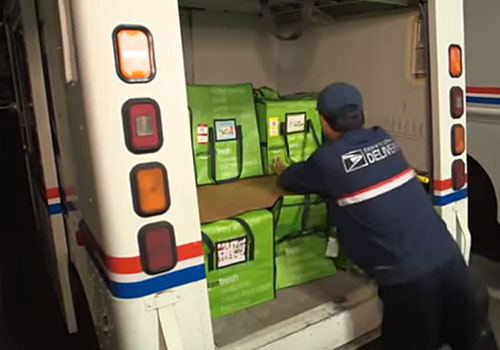
Statement of the honorable Alan Kessler, Vice Chairman Board of Governors United States Postal Service, Subcommittee on Federal Workforce, Postal Service, and the district of Columbia
Good afternoon, Chairman Davis and members of the Subcommittee. I appreciate the opportunity to testify today on behalf of the Governors of the Postal Service about the use of contract delivery services.
The issue being discussed here today is contracting. However, the issue for the Governors and the Postal Service is broader and more fundamental. The Postal Service must retain its ability to collectively bargain on a level playing field, and know that agreements that are reached after good faith negotiations, and the subjects of those negotiations and agreements, not be altered as a result of legislative action. The precedent set by legislatively over-riding a long-standing provision of a collective bargaining agreement is very dangerous for all parties. It is not hard to imagine how a future Congress with a different composition could tilt the playing field dramatically in a different direction.
I have had the honor of serving on the Board for almost seven years and the make-up of Congress has changed even in that time. One of the perspectives that I have gained as a Governor during that time is the importance of providing universal service to the American public at affordable rates. A touchstone for all Board decisions is to ensure that the citizens of our nation receive the quality service they deserve. However, I have seen the financial, operational, and human capital challenges confronting the Postal Service continue to mount. The Governors fully recognize and take very seriously the concerns the employee organizations have raised about the use of contractors to provide delivery service to the American public. We are also painfully aware, however, of the significant financial obstacles facing the Postal Service.
As you know, this country’s population continues to grow — and to expand geographically, with the creation of new suburban developments and urban high-rises, adding nearly 2 million new addresses to the Postal Service’s delivery network each year. At the same time, however, the growth in mail volume has slowed in the face of competition from electronic mail, online bill paying, and other forces.
The business model for the Postal Service – where steady growth in First-Class Mail finances the expansion of our delivery network to allow for affordable, universal service – is no longer working. The trend is clear. First-Class Mail, particularly single piece First-Class Mail, is no longer growing steadily. Standard Mail, which contributes significantly less than First-Class Mail to the Postal Service’s institutional costs, now comprises the majority of our volume.
As a result, we are delivering fewer pieces of First-Class Mail to each household and business, which means we can no longer rely on mail volume increases to cover the costs of an ever-expanding delivery network. The Postal Service has seen a decline in revenue per delivery point from USD 469 in 2000 to USD 433 in 2006 – a USD 36 drop per delivery point in just six years. This drop in revenue per delivery has occurred despite a 21% increase in postage rates over the same period. Despite this decline, the Postal Service has achieved positive financial results in the past few years. I want to applaud the Postal employees who have made this possible. By increasing productivity, our employees have allowed the Postal Service to remain financially sound. However, this volume trend is disturbing, as it clearly shows that the Postal Service cannot price its way out of this dilemma.
The Governors are also acutely aware of the new responsibilities placed upon the Postal Service by the Postal Act of 2006. The Act eliminated the escrow account and returned the military service obligation to the Department of Treasury. It also mandated that the Postal Service accelerate the funding of its retiree health benefits. Because of this requirement, the Postal Service reported a USD 3.8 billion loss at the end of the 2nd quarter of FY 2007, with a projected loss of USD 5.7 billion by end of the Fiscal Year.
In addition, the new law restricts the Postal Service’s flexibility when it comes to raising prices to cover its cost increases. The Postal Act broke the link between costs and prices by imposing a Consumer Price Index price cap on 90% of Postal revenues. This change was intended to encourage further cost reductions and efficiencies. In mandating a price cap, however, the new law did not provide the Board of Governors with any new cost control tools. The Governors are well aware of our fiduciary responsibility to the American public. Part of our duty in guiding the Postal Service and implementing the new law is to continually look for new ways to control costs: 80 percent of which are tied to labor. Consequently, productivity improvements, automation investments, and cost-control measures remain critical elements in controlling rapidly escalating delivery costs.
I would stress that the Postal Service is not considering taking work away from career carriers, who, I might add, perform an outstanding job. Nor is what is being discussed contracting out every new delivery. It is important to note that 92% of all new deliveries in 2007 continue to be assigned to Postal Service employees represented by unions. We are, however, prudently evaluating and debating whether it makes sense to assign distinct new work to career employees or to contractors. It is a valid and responsible business consideration.
And you may be assured that a number of factors are considered when determining whether to assign new deliveries to Postal Service employees or to contractors. While cost is a significant factor, it is just one of several factors contained in a long-established provision of our collective bargaining agreements. Other factors that must be evaluated, pursuant to those agreements, are efficiency, public interest, availability of equipment, and qualifications of employees.
As I have stated, the Postal Service is facing significant, growing cost pressures. If Congress were to completely eliminate the ability of the Postal Service to even consider the option of selectively using contract delivery service, its ability to effectively manage its vast delivery operations, and the associated costs, would be significantly restricted. I was on the Board when the Postal Service had more that $11 billion in debt. That was a huge burden to carry; simply servicing the debt was expensive. It is very clear that the Postal Service has to take thoughtful, serious actions to continue to control costs or we will be back on track to potentially incurring significant debt.
As Governors, with the responsibility of guiding the Postal Service, we have to be very concerned about the precedent of legislative intervention in the collective bargaining agreements with our employees. If Congress acts on restricting or eliminating the option of contract delivery, what other work would be next? This is a dangerous step on a very slippery slope. While today it might advantage the employees, in the future, a different Congress might intervene on issues adverse to employees interests.
In addition, a virtual prohibition on contract delivery service would also impact small businesses, which would be denied the opportunity to bid on contracts for transporting and delivering mail. I am not overstating this point – 99 pct of our existing contract delivery services are performed by small businesses. Of these small business contracts, 15pct are to minority-owned small businesses and 45 pct are with women-owned small businesses.
The Postal Service’s use of private sector services is not a 21st Century development. The Postal Service has used contractors to transport and deliver mail since 1785, when Congress first authorized the Post Office Department to contract with stagecoach companies. In fact, the storied Pony Express was a contractor to the Postal Service.
Much of the mail you receive each day—whether delivered by a City Letter Carrier or a Rural Letter Carrier—has been handled by contractors providing over-the-road or air transportation. Moreover, the postage stamp that paid for that mail may have been purchased at a supermarket, convenience, stationery, or greeting card store. In addition, it is quite possible that the postage was applied by a postage meter, which are all owned and leased by a private-sector provider. And it is very likely that many of you have had experience with one of our contract postal retail units, nearly 4,000 of which are operated by respected local business people in their communities.
In addition, the Postal Service, with the concurrence of the Postal Regulatory Commission, uses our rate schedule to effectively incent mailers and consolidators to presort and transport the mail. Through the use of work share discounts, valued at roughly USD 18 billion last year, an entire industry has flourished which led to increased mail volume and revenue. These are just a few of the ways that the Postal Service, in cooperation with the private sector, provides high-quality, consistent service to the American public in the most cost-effective and efficient manner.
By augmenting the services that the Postal Service provides directly with those services provided by our partners in private industry, we have been able to contribute to the economy. The Postal Service and the industries it supports account for roughly 9 pct of Gross Domestic Product or USD 900 billion. The Postal Service has been able to sustain this contribution by better managing costs, improving efficiency, and providing access that is even more convenient for our customers. When viewed within the context of all Postal services, contract delivery service represents less than 2% of our total deliveries.
The Governors recognize the legitimate questions that have been raised about the qualifications of contractors. The Postal Service takes a number of steps in assessing contractors and subcontractors who are selected to provide mail delivery service. Potential contractors undergo background checks, screening, and fingerprinting, just as our career employees do. The Postal Inspection Service, the federal law enforcement agency charged with protecting the security of the mail, ultimately determines the suitability of contractors.
I would like to emphasize that these same collective bargaining agreements protect the vast majority of union-represented Postal employees from lay-offs. No career carrier is being laid-off, or will be laid off, so that we can contract out his or her job. Both the contracting-out provision and the no lay-off provision of these agreements were the product of negotiations, a give and take between two parties, the Postal Service and the union, each of whom gained some rights and lost some rights during the negotiations.
As you are all aware, the collective-bargaining process is a complex exchange of positions, ideas, and proposals, which the Postal Act of 2006 did not change. In fact, the Act emphasized that parties should try to come to an agreement by adding a mediation step to the process. Negotiations require each party to consider and adjust its own priorities in light of the priorities of the other party. Ultimately, the process is intended to produce a working agreement containing provisions that are acceptable both to management and to the labor unions—provisions that also work for our customers. If the parties are unable to agree, Title 39 requires the use of binding arbitration to settle the dispute.
The current contracting provisions in the collective bargaining agreements are the product of good faith negotiations conducted regularly since the first contracting Article was included in the agreements in the early 1970’s. The Postal Service is bound by these collective bargaining agreements and operates under them. To the extent that either party wants changes to the agreement, the collective bargaining process is the place to discuss those proposals. I would note that this process is currently on-going with our one of our carrier unions.
The Governors are fully aware of our responsibility under Title 39. We provide policy guidance to senior management of the Postal Service, but the Governors do not negotiate – that is the responsibility of management. The Governors have encouraged Postmaster General Potter and his management team to do their best to achieve a negotiated settlement with our unions. Just last week, after a positive briefing on the subject with the Board, the Postal Service reached an agreement with the National Association of Letter Carriers (NALC) that, among other things, included provisions dealing with contract delivery services. The Postal Service is still working through the statutory process to conclude an agreement with the National Rural Letter Carriers’ Association (NRLCA).
During my time on the Board, I have seen that the collective bargaining process has worked. The Postal Service and its unions have succeeded in reaching negotiated agreements that were beneficial for both parties. Prior to 1998, and prior to my service on the Board, it was commonplace for the parties to resolve their differences through third-party arbitrators. It is our sincere belief that negotiated agreements, where the parties decide their own fate, are far preferable. Since December, the Postal Service has reached negotiated agreements with all four of its largest unions. While one was not ratified and remains under discussion, we are proud that these agreements dealt with important issues that will lead to increased productivity and quality service.
In short, our responsibility as Governors is to ensure the Postal Service provides universal service at a reasonable price. We must balance the provision of that service with the cost of providing the service. We, as a group, are committed to providing a high level of service to the American people. Our mandate is to achieve this goal under the requirements of the new law and our collective bargaining agreements.












